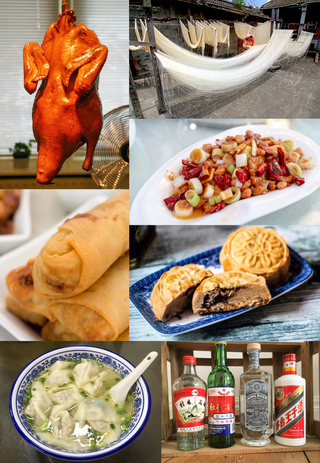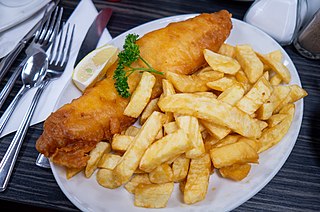
Chinese cuisine comprises cuisines originating from China, as well as from Chinese people from other parts of the world. Because of the Chinese diaspora and historical power of the country, Chinese cuisine has profoundly influenced many other cuisines in Asia and beyond, with modifications made to cater to local palates. Chinese food staples such as rice, soy sauce, noodles, tea, chili oil, and tofu, and utensils such as chopsticks and the wok, can now be found worldwide.

Moroccan cuisine is the cuisine of Morocco, fueled by interactions and exchanges with many cultures and nations over the centuries. Moroccan cuisine is usually a mix of Berber, Andalusi, Mediterranean, and Arab cuisines, with minimal European and sub-Saharan influences. Like the rest of the Maghrebi cuisine, Moroccan cuisine has more in common with Middle Eastern cuisine than with the rest of Africa.

The cuisine of the Southern United States encompasses diverse food traditions of several subregions, including Tidewater, Appalachian, Ozarks, Lowcountry, Cajun, Creole, African American Cuisine and Floribbean cuisine. In recent history, elements of Southern cuisine have spread to other parts of the United States, influencing other types of American cuisine.
Breakfast is the first meal of the day usually eaten in the morning. The word in English refers to breaking the fasting period of the previous night. Various "typical" or "traditional" breakfast menus exist, with food choices varying by regions and traditions worldwide.

English cuisine encompasses the cooking styles, traditions and recipes associated with England. It has distinctive attributes of its own, but is also very similar to wider British cuisine, partly historically and partly due to the import of ingredients and ideas from the Americas, China, and India during the time of the British Empire and as a result of post-war immigration.
The following outline is provided as an overview of and topical guide to meals:

Hungarian or Magyar cuisine is the cuisine characteristic of the nation of Hungary, and its primary ethnic group, the Magyars. Hungarian cuisine has been described as being the spiciest cuisine in Europe. This can largely be attributed to the use of their piquant native spice, Hungarian paprika, in many of their dishes. A mild version of the spice, Hungarian sweet paprika, is commonly used as an alternative. Traditional Hungarian dishes are primarily based on meats, seasonal vegetables, fruits, bread, and dairy products.

Pakistani cuisine can be characterized as a blend of regional cooking styles and flavours from across South, Central and Western Asia. Pakistani cuisine is influenced by Persian and Arab cuisine. The cuisine of Pakistan also maintains certain Mughal influences within its recipes and cooking techniques. The country's various cuisines vary across the country. Pakistan's ethnic and cultural diversity, diverse climates, geographical environments, and availability of different produce options reason for the uniqueness of pakistani cuisine.

Bengali cuisine is the culinary style of Bengal, that comprises Bangladesh and the Indian states of West Bengal and Tripura. The cuisine has been shaped by the region's diverse history and climate. It is known for its varied use of flavours including mustard oil, as well as the spread of its confectioneries and desserts. There is a strong emphasis on rice as a staple, with fish traditionally the most common protein. Freshwater fish are preferred to seafish, although barramundi, known as bhetki, is also common. Meat is also a common protein among Bengalis with beef and goat meat being the most popular. In more recent times, lentils have begun to form a significant part of the diet. Many Bengali food traditions draw from social activities, such as adda, Eid feast or the Mezban.

Yemeni cuisine is distinct from the wider Middle Eastern cuisines, but with a degree of regional variation. Although some foreign influences are evident in some regions of the country, the Yemeni kitchen is based on similar foundations across the country.

Uzbek cuisine shares the culinary traditions of peoples across Central Asia. There is a great deal of grain farming in Uzbekistan, so breads and noodles are of importance, and Uzbek cuisine has been characterized as "noodle-rich". Mutton is a popular variety of meat due to the abundance of sheep in the country and it is a part of various Uzbek dishes.

Somali cuisine has moderate foreign influence from different countries mainly due to trade, but traditionally also varies from region to region due to the expansive landmass Somalis inhabit. It is the product of Somalia's tradition of trade and commerce. Some notable Somali specialties include kimis/sabaayad, canjeero/lahoh, xalwo (halwa), sambuusa (samosa), bariis iskukaris, and muqmad/odkac.

British cuisine is the specific set of cooking traditions and practices associated with the United Kingdom, including the cuisines of England, Scotland, Wales and Northern Ireland. According to food writer Colin Spencer, historically, British cuisine meant "unfussy dishes made with quality local ingredients, matched with simple sauces to accentuate flavour, rather than disguise it".

Afghan cuisine is influenced to a certain extent by Persian, Central Asian and Indian cuisines due to Afghanistan's close proximity and cultural ties. The cuisine is halal and mainly based on mutton, beef, poultry and fish with rice and Afghan bread. Accompanying these are common vegetables and dairy products, such as milk, yogurt, whey, etc., and fresh and dried fruits such as apples, apricots, grapes, bananas, oranges, plums, pomegranates, sweet melons, raisins, etc. The diet of most Afghans revolves around rice-based dishes, while various forms of naan is consumed with most meals. Tea is generally consumed daily in large quantities, and is a major part of hospitality. The culinary specialties reflect the nation's ethnic and geographic diversity. The national dish of Afghanistan is Qabili Palau, a rice dish cooked with raisins, carrots, nuts, and lamb or beef.

Sephardic Jewish cuisine is an assortment of cooking traditions that developed among the Sephardi Jews.

The cuisine of early modern Europe was a mix of dishes inherited from medieval cuisine combined with innovations that would persist in the modern era.

The cuisine of the antebellum United States characterizes American eating and cooking habits from about 1776 to 1861. During this period different regions of the United States adapted to their surroundings and cultural backgrounds to create specific regional cuisines, modernization of technology led to changes in food consumption, and evolution of taverns into hotels led to the beginnings of an American temperance movement. By the beginning of the Civil War, the United States cuisine and food culture could define itself separately from that of the rest of the world.
The following outline is provided as an overview of and topical guide to cuisines:

Middle Eastern cuisine or West Asian cuisine includes a number of cuisines from the Middle East. Common ingredients include olives and olive oil, pitas, honey, sesame seeds, dates, sumac, chickpeas, mint, rice and parsley, and popular dishes include kebabs, dolmas, falafel, baklava, yogurt, doner kebab, shawarma and mulukhiyah.

A meal is an eating occasion that takes place at a certain time and includes consumption of food. The names used for specific meals in English vary, depending on the speaker's culture, the time of day, or the size of the meal.

















